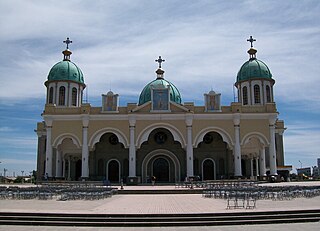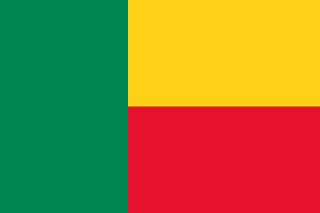Eritrea has an estimated population of 4,954,645 as of 2016. No reliable census data is available, the best available estimates being published by the Population Division of the United Nations Department of Economic and Social Affairs. The population has doubled over the past 30 years, with an accelerating growth rate estimated at close to 3.2% p.a. during 2005–2010. This rate of population growth is sustained despite a high emigration rate; the World Bank as of 2010 estimated that close to a million of Eritreans have emigrated.
Religion in Africa is multifaceted and has been a major influence on art, culture and philosophy. Today, the continent's various populations and individuals are mostly adherents of Christianity, Islam, and to a lesser extent several Traditional African religions. In Christian or Islamic communities, religious beliefs are also sometimes characterized with syncretism with the beliefs and practices of traditional religions.

Islam is one of the major religions practiced widely in Ghana. Its presence in Ghana dates back to the 10th century. The population of Muslims in Ghana is about 20%.

Islam is the majority religion of the Gambia, with around 95% of the population being Muslims. Other religious societies are made up of Catholics, Protestants, and Traditional African religion. Islam in the Gambia is characterized by its coexistence with other religions. The majority of its Muslims are Sunni belonging to Maliki school of jurisprudence, influenced with Sufism. The Ahmadiyya movement is also present. However, some popular religious and tribal practices diverge from mainstream Islam, with a system of marabout societies being very common.

Religion in Ethiopia consists of a number of faiths. Among these mainly Abrahamic religions, the most numerous is Christianity totaling at 62.8%, followed by Islam at 33.9%. There is also a longstanding but small Jewish community. Some adherents of the Bahá'í Faith likewise exist in a number of urban and rural areas. Additionally, there are a few followers of traditional faiths, who mainly reside in the southwestern part of the country.

Mirza Masroor Ahmad is the current and fifth caliph, and leader of the worldwide Ahmadiyya Muslim Community. He was elected as the fifth successor of the founder of the movement—Mirza Ghulam Ahmad—on 22 April 2003, three days after the death of his predecessor Mirza Tahir Ahmad, the fourth Caliph of the Ahmadiyya Muslim Community.

This is an overview of religion by country according to the Pew Research Center. The article Religious information by country gives information from The World Factbook of the CIA and the U.S. Department of State.

Islam is a minority religion in the Solomon Islands. The religion first entered the country in 1987, when a Ghanaian missionary belonging to the Ahmadiyya movement visited Guadalcanal island on a reconnaissance trip lasting three years. Today, there are two major denominations in the country - Ahmadi Muslims and Sunni Muslims. According to a 2007 report by the United States Department of State's International Religious Freedom Report, there are approximately 350 Muslims in the country. However, different reports suggest that there may be 1000 Ahmadi Muslims in the country alone.
Christianity is the predominant religion in Republic of the Congo.

Christianity is the most widely professed religion in Benin, with 48.5% of the nation's total population being members of various Christian denominations. Consequently, it plays an important role in shaping the country's social and cultural life.

Christianity is the dominant religion in Eswatini. The relative prevalence percentage vary by source. According to Pew Research, over 88% of the total 1.2 million population of Eswatini express Christianity to be their faith, over 10% express no affiliation. According to the US State Department religious freedom report of 2012, local religious leaders estimate that 90% of Eswatini's population is Christian, 0.2% is Muslim, while under 10% belong to other religious groups. According to the CIA world fact book, the distribution is 40% Zionist, 20% Roman Catholic, Muslim 0.2%, other 30%. In other sources such as Clay Potts, the religious demographics are 80% Christian, and 20% Traditional Swazi religion.

Muslims constitute 90 percent of the population of the Gambia according to CIA factbook. The vast majority are Malikite Sunnis influenced with Sufism, of which the main orders represented are Tijaniyah, Qadiriyah. Except for Ahmadiyya, Sufi orders pray together at common mosques. A small percentage of Muslims, predominantly immigrants from South Asia, do not ascribe to any traditional Islamic school of thought.

Islam is a minority religion in the island nation Tuvalu. With the introduction of Islam in 1985 by Ahmadi Muslims, there are approximately 50 Muslims in the country, of which all are members of the Ahmadiyya movement. Due to the country's small population, this represents 0.5% of Tuvalu. The Tuvalu Mosque, in Funafuti, the capital of Tuvalu, is the only mosque in the country.

Ahmadiyya is an Islamic revival or messianic movement founded in Punjab, British India, in the late 19th century. It originated with the life and teachings of Mirza Ghulam Ahmad (1835–1908), who claimed to have been divinely appointed as both the promised Mahdi and Messiah expected by Muslims to appear towards the end times and bring about, by peaceful means, the final triumph of Islam; as well as to embody, in this capacity, the expected eschatological figure of other major religious traditions. Adherents of the Ahmadiyya—a term adopted expressly in reference to Muhammad's alternative name Aḥmad—are known as Ahmadi Muslims or simply Ahmadis.

Ahmadiyya is an Islamic movement in Indonesia. The earliest history of the Community in Indonesia dates back to the early days of the Second Caliph, when during the summer of 1925, roughly two decades prior to the Indonesian revolution, a missionary of the Community, Rahmat Ali, stepped on Indonesia's largest island, Sumatra, and established the movement with 13 devotees in Tapaktuan, in the province of Aceh. The Community has an influential history in Indonesia's religious development, yet in the modern times it has faced increasing intolerance from religious establishments in the country and physical hostilities from radical Muslim groups. The Association of Religion Data Archives estimates around 400,000 Ahmadi Muslims, spread over 542 branches across the country.

Majlis Khuddam-ul-Ahmadiyya, which literally means "Association of the Servants of Ahmadiyya", is one of the five auxiliary organizations within the Ahmadiyya Muslim community. It is the young men's branch of the community, particularly for those between the ages of 15 and 40. In some English-speaking countries, the organization is also known as the Ahmadiyya Muslim Youth Association (AMYA).

Between 0.22% and 2.2% of Pakistan's population is Ahmadi. Hence Pakistan is the home to the largest population of Ahmadis in the world. The city of Rabwah in Punjab, Pakistan used to be the global headquarters of the Ahmadiyya Community before they were moved to England. The Ahmadiyya population in Pakistan has often come under persecution and discrimination by the Sunni majority.

Ahmadiyya is an Islamic religious movement originating in 1889 in northern India around the teachings of Mirza Ghulam Ahmad (1835–1908), who claimed to have been divinely appointed as both the promised Mahdi and Messiah expected by Muslims to appear towards the end times.

Ahmadiyya is an Islamic branch in the United States. The earliest contact between the American people and the Ahmadiyya movement in Islam was during the lifetime of Mirza Ghulam Ahmad. In 1911, during the era of the First Caliphate of the Community, the Ahmadiyya movement in India began to prepare for its mission to the United States. However, it was not until 1920, during the era of the Second Caliphate, that Mufti Muhammad Sadiq, under the directive of the caliph, would leave England on SS Haverford for the United States. The U.S. Ahmadiyya movement is considered by some historians as one of the precursors to the Civil Rights Movement in America. The Community was the most influential Muslim community in African-American Islam until the 1950s. Today, there are approximately 15,000 to 20,000 American Ahmadi Muslims spread across the country.

Adherents of Islam constitute the world's second largest religious group. According to a study in 2015, Islam has 1.8 billion adherents, making up about 24.1% of the world population. Most Muslims are either of two denominations: Sunni or Shia. Islam is the dominant religion in Central Asia, Indonesia, Middle East, North Africa, the Sahel and some other parts of Asia. The diverse Asia-Pacific region contains the highest number of Muslims in the world, easily surpassing the Middle East and North Africa.














